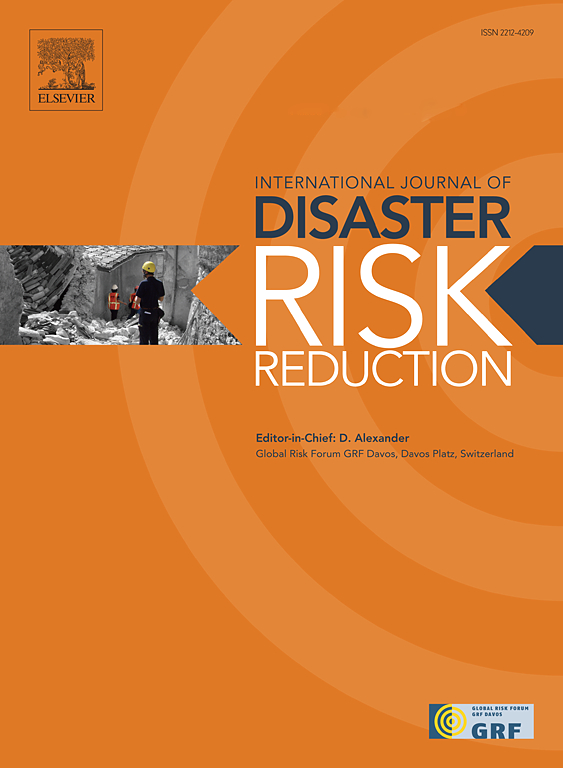Predicting and forecasting disasters: A global scan of traditional and local knowledge
IF 4.2
1区 地球科学
Q1 GEOSCIENCES, MULTIDISCIPLINARY
International journal of disaster risk reduction
Pub Date : 2025-05-20
DOI:10.1016/j.ijdrr.2025.105590
引用次数: 0
Abstract
For centuries, people worldwide have predicted disasters based on observations and experimentation, interpreting animal behavior, plant responses, weather patterns, and celestial phenomena. Despite its significance, such traditional and local knowledge remains under-researched and undocumented, limiting its potential for integration in disaster risk reduction. This review consolidates traditional and local knowledge from 53 research articles, covering 423 cases categorized into three broad indicators: astronomical, meteorological, and biological. These indicators encompass 33 sub-indicators, such as sky, wind, birds, and soil, providing location- and disaster-specific contexts for prediction. Meteorological disasters (e.g., tropical cyclones, storms, and mass movements) constituted the largest share (33 %), followed by hydrological (e.g., floods and storm surges) and climatological disasters (e.g., droughts) (27 %). While there were disaster-specific variations, animal behavior (mammals, insects, birds, etc.) were the most commonly used predictive indicator (39 %), followed by water-related indicators (12 %), plant phenology (9 %), wind (8 %), and both cloud patterns and temperature (5 % each). Other indicators, including observations of the sun, moon, sky, stars, lightning, and rainfall, collectively constituted the remaining 22 %. There were notable similarities and differences in disaster prediction within and across countries in terms of the indicators used. It is, therefore, important to contextualize and localize prediction patterns rather than generalize them. However, scientific metrics need to be explored to assess their broader applicability. This would be a crucial step in harnessing traditional knowledge for integrating effective prediction methods, which requires increased funding and research efforts.
预测和预报灾害:传统和地方知识的全球扫描
几个世纪以来,世界各地的人们都根据观察和实验来预测灾难,解释动物行为、植物反应、天气模式和天体现象。尽管具有重要意义,但这些传统和地方知识仍然没有得到充分的研究和记录,限制了将其纳入减少灾害风险的潜力。这篇综述整合了53篇研究文章中的传统知识和地方知识,涵盖了423个案例,这些案例分为三个大类:天文学、气象学和生物学。这些指标包括33个子指标,如天空、风、鸟类和土壤,为预测提供了特定地点和灾害的背景。气象灾害(如热带气旋、风暴和群众运动)所占比例最大(33%),其次是水文灾害(如洪水和风暴潮)和气候灾害(如干旱)(27%)。虽然存在特定灾害的差异,但动物行为(哺乳动物,昆虫,鸟类等)是最常用的预测指标(39%),其次是与水相关的指标(12%),植物物候(9%),风(8%)以及云模式和温度(各占5%)。其他指标,包括对太阳、月亮、天空、星星、闪电和降雨的观测,共同构成了剩余的22%。就所使用的指标而言,各国内部和各国之间的灾害预测有显著的相似和差异。因此,重要的是对预测模式进行上下文化和本地化,而不是泛化它们。然而,需要探索科学指标来评估其更广泛的适用性。这将是利用传统知识整合有效预测方法的关键一步,这需要增加资金和研究工作。
本文章由计算机程序翻译,如有差异,请以英文原文为准。
求助全文
约1分钟内获得全文
求助全文
来源期刊

International journal of disaster risk reduction
GEOSCIENCES, MULTIDISCIPLINARYMETEOROLOGY-METEOROLOGY & ATMOSPHERIC SCIENCES
CiteScore
8.70
自引率
18.00%
发文量
688
审稿时长
79 days
期刊介绍:
The International Journal of Disaster Risk Reduction (IJDRR) is the journal for researchers, policymakers and practitioners across diverse disciplines: earth sciences and their implications; environmental sciences; engineering; urban studies; geography; and the social sciences. IJDRR publishes fundamental and applied research, critical reviews, policy papers and case studies with a particular focus on multi-disciplinary research that aims to reduce the impact of natural, technological, social and intentional disasters. IJDRR stimulates exchange of ideas and knowledge transfer on disaster research, mitigation, adaptation, prevention and risk reduction at all geographical scales: local, national and international.
Key topics:-
-multifaceted disaster and cascading disasters
-the development of disaster risk reduction strategies and techniques
-discussion and development of effective warning and educational systems for risk management at all levels
-disasters associated with climate change
-vulnerability analysis and vulnerability trends
-emerging risks
-resilience against disasters.
The journal particularly encourages papers that approach risk from a multi-disciplinary perspective.
 求助内容:
求助内容: 应助结果提醒方式:
应助结果提醒方式:


